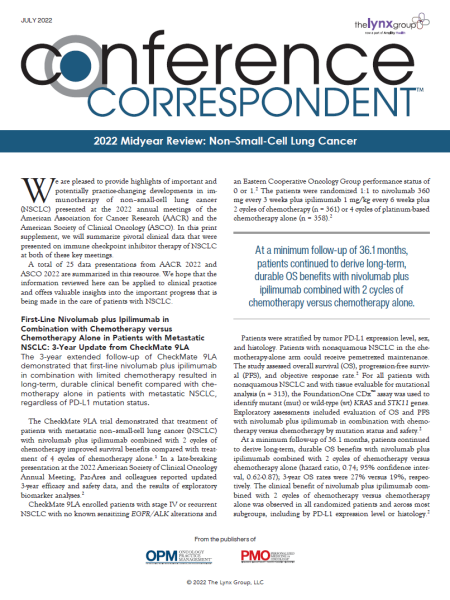The most recent data estimate that approximately 234,030 new cases of lung cancer were diagnosed in 2018, and the probability of diagnosis increases as one ages.1 It is estimated that more than 154,050 deaths due to lung cancer occurred in 2018, accounting for 25% of all cancer deaths in women and 26% in men, making lung cancer the leading cause of cancer mortality in men and women.1
The incidence and mortality of non–small-cell lung cancer (NSCLC) led to a number of unmet needs in the screening and diagnosis, treatment, and overall management of patients with NSCLC. For example, while it is recommended that individuals aged 55 to 80 years who smoke or have quit within the past 15 years and have accumulated at least 30 pack-years of cigarette smoking undergo yearly computed tomography (CT) screening, these criteria lead to fewer ever-smokers eligible for screening.2 To avert lung cancer death through CT screening, eligibility criteria need to capture high-risk smokers, such as the substantially increasing number of individuals with a smoking history of 20 to 29 pack-years, through risk-based criteria using a validated lung cancer risk tool.2
Advances in molecular profiling have led to discovery of several oncogenic drivers of NSCLC, including epidermal growth factor (EGFR) mutations, anaplastic lymphoma kinase (ALK) rearrangements, ROS1 mutations, BRAF mutations, MET exon 14 skipping mutations, human epidermal growth factor receptor 2 (HER2) mutations, NTRK gene alterations, and rearrangement during transfection (RET) rearrangements.3 However, it is unclear whether tissue biopsy or liquid biopsy is best for molecular profiling. Although liquid biopsy can assess tumor DNA in plasma from all tumor sites, is relatively noninvasive, can identify genomic abnormalities at diagnosis and when resistance is acquired, and can be repeated serially, tissue biopsy allows for tumor mutational burden to be measured as a predictor for efficacy of immune checkpoint inhibitors.3
Although targeted therapies have substantially improved overall survival for patients with oncogenic drivers, immunotherapy has been a critical advance for patients without a driver mutation.4 Immune checkpoint inhibitors have evolved to front-line treatment for patients with metastatic NSCLC; however, when primary or acquired resistance occurs, there is little evidence for effective treatment options in the second-line setting, creating a major unmet need in the treatment of patients with metastatic NSCLC.
Finally, most lung cancer diagnoses occur at late stages, leading to a historical 5-year survival rate of only 5%.1 However, new treatments, including targeted therapies, and new insights into treatment sequencing are improving survival and changing NSCLC to a chronic disease where patients survive years rather than months. As a result, patients now face new challenges in managing side effects from multimedication regimens, as well as the psychosocial burdens of living with cancer. More than 95% of patients report ≥1 medication side effects, with anxiety, fatigue, and shortness of breath the most common long-term posttreatment side effects; gastrointestinal issues were the most common during treatment; and pain, loss of appetite, and weight loss were the most problematic across all time periods.5
Furthermore, patients report substantial emotional burden associated with lung cancer survivorship that requires patient education and shared decision-making, as well as emotional, social, and financial support.6 Overall, patients report that healthcare providers focus on survival rather than managing side effects and a need for a better healthcare experience, making side-effect management and psychosocial support substantial unmet needs to improve the care and experience of patients living with NSCLC.5,6
References
- Siegel RL, Miller KD, Jemal A. Cancer statistics, 2018. CA Cancer J Clin. 2018;68:7-30.
- Cheung LC, Katki HA, Chaturvedi AK, et al. Preventing lung-cancer mortality by CT screening: the effect of risk-based versus USPSTF eligibility criteria, 2005-2015. Ann Intern Med. 2018;168:229-232.
- Pennell NA, Arcila ME, Gandara DR, West H. Biomarker testing for patients with advanced non–small cell lung cancer: real-world issues and tough choices. Am Soc Clin Oncol Educ Book. 2019;39:531-542.
- Santos ES, Schmidt CE. Treatment options after first-line immunotherapy in metastatic NSCLC. Expert Rev Anticancer Ther. 2020;20:221-228.
- King J, Bankhead J, Rigney M. Unmet needs in physical and emotional side effects during lung cancer treatment and survivorship. J Thorac Oncol. 2017;12(Suppl 1):S327.
- Al Achkar M, Marchand L, Thompson M, et al. Unmet needs and opportunities for improving care for patients with advanced lung cancer on targeted therapies: a qualitative study. BMJ Open. 2020;10:e032639.

